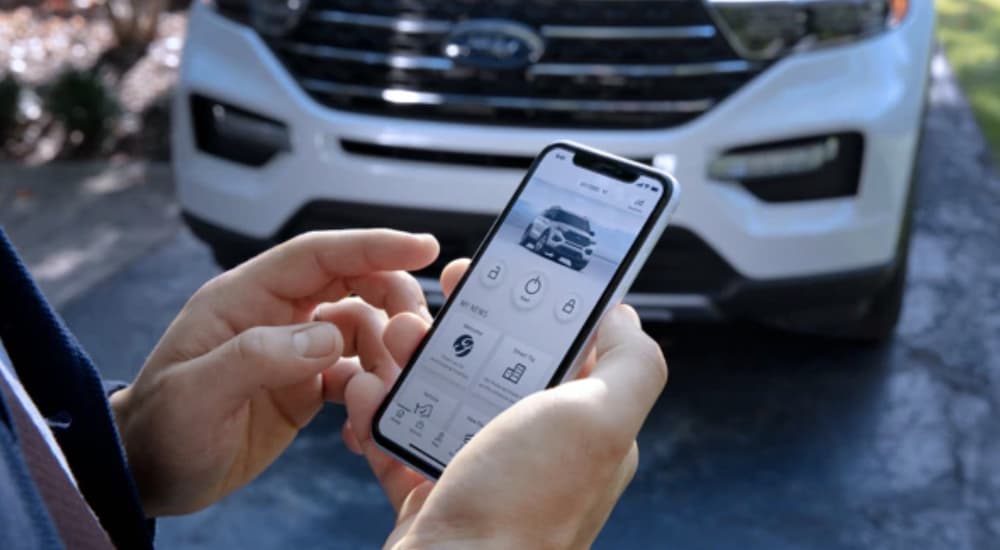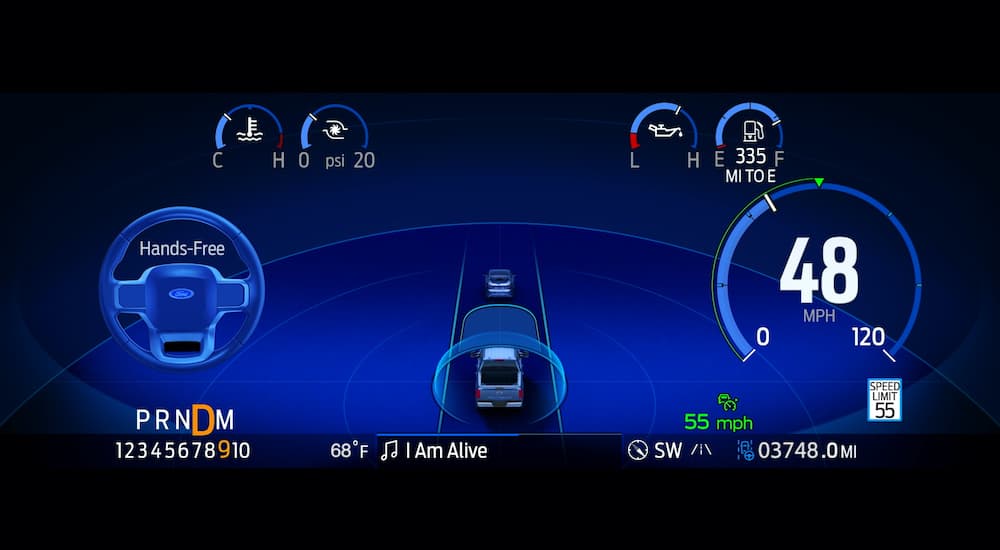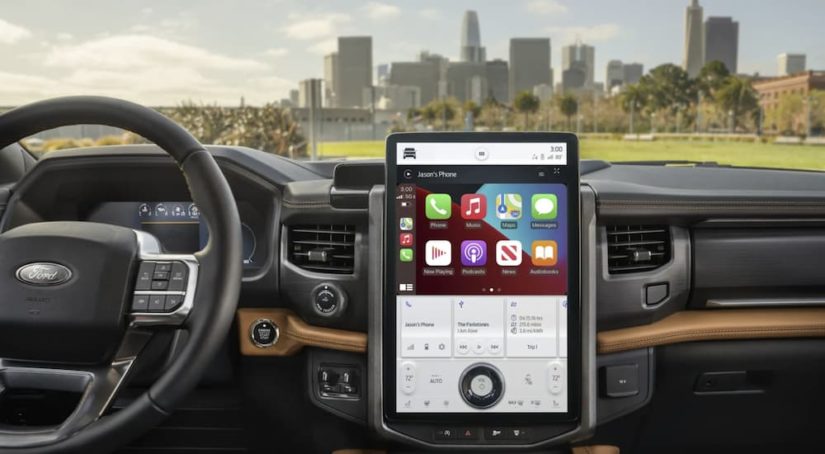When was the last time you looked in on the large SUV category? Also known as land yachts, these behemoth people movers are the upscale equivalent of airport shuttles, easily accommodating eight passengers and their luggage with room to spare. The raft of available models includes the newly refreshed 2022 Ford Expedition. Among the many changes to this perennial favorite is a completely modernized infotainment system.
Giant SUVs are favored by busy families seeking more elbow room, and these buyers commonly opt for top-of-the-line trims that include plush leather seating and elaborate climate control systems. While these vehicles were historically coveted for their expansive exterior space, nowadays, buyers choose them for something else: the expansive available onboard entertainment systems.
Nothing ruins a road trip faster than a back seat sibling squabble, so families turn to in-vehicle entertainment to escape from constant refereeing. Vehicles like the 2022 Expedition offer Amazon Fire streaming on dedicated rear seat entertainment screens, along with multi-speaker premium audio systems for front seat passengers. As if that’s not enough, robust Wi-Fi hotspots can accommodate multiple devices, keeping everyone connected (and quiet).
Touchscreens and Operating Systems
It’s a race to build the biggest onboard infotainment system, and as of now, Ford is in one of the top spots. The new 2022 Expedition features an available 15.5-inch touchscreen that’s portrait mounted for even more dashboard prominence. Only the Cadillac Escalade and the Tesla Model S and X beat it, with the former measuring 16.9 inches and the latter coming in at a dramatic 17 inches. It’s not surprising that Tesla leads the touchscreen size wars, since EVs in particular, rely on display-based data to keep drivers informed about charge levels.
Some manufacturers, like Range Rover, split the difference, offering dual 10-inch screens. One displays infotainment, while the other is dedicated to climate control. Audi’s Q7 SUV also features a dual-screen setup, albeit a smaller one at 10.1 inches and 8.6 inches. Any discussion of infotainment screens is incomplete without mentioning the upcoming Cadillac Lyriq, which is rumored to feature a continuous 34-inch curved LED screen. Ford’s 15.5-inch screen sticks out, though, because it’s the only one of its size among non-luxury automotive manufacturers.
Size is only one half of the discussion, though, because without a robust and responsive operating system, that giant screen is just another pretty piece of trim. Most automotive reviewers agree that Ford’s newest machine learning SYNC 4 operating system takes the prize for the most intelligent and user-friendly infotainment interface. It adapts to different vehicles and screen sizes and has the ability to multitask, as well as receive over-the-air updates, thanks to cloud connectivity.
Nipping aggressively at Ford’s heels is the Stellantis Uconnect system. Tech-savvy reviewers agree that the system works best on larger touchscreens like the 12-inch version found on upper-level Ram pickup truck trims. Uconnect’s voice recognition is among the best available, which makes voice-to-text infinitely less frustrating. Screen displays are crisp and clear, and the system is modified with special capabilities for different vehicles in the lineup.

Premium Audio Systems
Advanced, multi-speaker audio systems are a hallmark of luxury vehicles, but these days if you travel high enough in the trim range, you’ll find them everywhere, including on minivans and entry-level crossovers. The tweaked 2022 Ford Expedition receives an optional best-in-class 22-speaker Bang & Olufsen surround sound system designed specifically for the Expedition’s cabin.
Bang & Olufsen is the preferred audio brand of many of the world’s most prestigious auto brands, including Bentley, Aston Martin, and Lamborghini. Interestingly, the six-figure Bentley features a B&O audio system with just 20-speakers. We admit it’s an oversimplification to equate speaker quantity with audio quality, but that Ford makes available such a complex system in the Expedition lineup speaks volumes about the company’s focus on SUV luxury.
Other premium audio brands, including Burmester, McIntosh, Bose, and ELS Studio, appear prominently in various models’ flagship trims. Speaker placement is another evolving audio technology that seeks to optimize wattage and sound output. Even the quirky, affordable Nissan Kicks optimizes sound quality with headrest-mounted speakers.
Combining high-performance audio systems with complementary cabin acoustics is another emerging automotive trend. Noise-canceling technology, acoustic glass, and sound leveling are some of the tools automakers deploy to achieve concert-grade sound. The upcoming Lyriq has Adaptive Volume and Surround Technology, which Cadillac claims will create “an immersive listening experience.”
The Bose Active Sound Management system mimics the technology found in its noise-canceling headphones. The company uses Engine Harmonic Cancelation to eliminate engine noise with opposing sound waves and a similar QuietComfort system for road noise control. Interestingly, the company is on the cutting edge of creating audio environments for EVs, vehicles that don’t have to combat engine noise at all.
Connected Services
Smartphones have ushered in a level of convenience we couldn’t have imagined even a decade ago. With smart home devices like Alexa carrying that theme into the home, it was only a matter of time before the technology expanded once again to include our vehicles. Via apps like FordPass, vehicle owners can subscribe to services that transform their smartphones into virtual keys.
FordPass Connect lets owners remotely control their vehicles, including locking and unlocking their doors, sounding the horn, and even starting the vehicle, including pre-setting the cabin temperature. The app stores important vehicle data, like mileage, fuel level, and maintenance schedules/reminders. EV data includes charge level and a search feature that helps drivers find nearby charging stations.
The FordPass Connect system also lets Ford owners access their roadside assistance benefits. Via the app, drivers can request help for a variety of problems, including running out of gas, requesting a tow truck, changing a flat tire, and jumping a dead battery. The app also stores vehicle owner’s manuals, so they’re much easier to search, and the FordPass app is the gateway to accessing vehicle-wide Wi-Fi hotspots.
Tesla adds playful extras to its connectivity system, including Caraoke, an in-vehicle karaoke system complete with streaming lyrics, as well as video games from Atari and Nintendo. The system’s navigation capabilities include an “I’m feeling hungry” option that automatically selects a restaurant for you and an enhanced Tesla Supercharger station locator that directs drivers to the charging station and previews availability and cost.

In-Vehicle Technology Is in the Early Stages
As exciting as these vehicle technologies are in their current form, most experts agree the systems are in their infancy. Much like the evolution of computers and smart TVs, we can expect an exponential increase in system intelligence and capabilities. Not only that, but the roads we drive on are capable of communicating with onboard vehicle technology. So-called smart highways help power Ford’s BlueCruise hands-free cruise control.
Vehicle-to-vehicle communication in the context of smart highways can help avoid collisions and minimize traffic snarls, and eventually, autonomous driving technology will free up drivers to participate in gaming and even stream entertainment content on long highway drives. Partnerships with Amazon will further connect home and vehicle, allowing drivers to turn on home heating and exterior lights in advance of their arrival.
Between Google, Amazon, and global automakers, an expected $21.5 billion will be spent on developing infotainment technology over the next five years. The result of all that investment will be secure, encrypted in-vehicle capabilities that integrate with smartphone and in-home smart device technology. The overarching goal: to make life easier and more connected for consumers.



